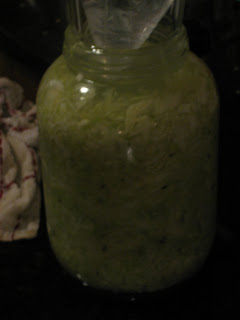Sauerkraut is incredibly simple. In fact, it is just cabbage and salt. For this batch, I threw in some juniper berries and caraway seeds to spice things up.
I used one and a half large heads of green cabbage, which yielded a bit under five useable pounds (I think) after I had removed damaged leaves and cored the heads. By far the most difficult part of the process is shredding the cabbage really fine - this is where a kraut board, which is basically a huge mandoline comes in. Of course, I don't have one, so I just chopped away.
Once the cabbage was shredded, I tossed it with:
3 tablespoons salt,
1 tablespoon whole juniper berries (which I picked in New Mexico)
and 1 tablespoon caraway seeds

Once everything is mixed together, place in a jar or crock of the appropriate size and weight with a plastic bag filled with water, or, as I eventually did, a glass full of water which happened to fit the jar perfectly. The cabbage should release enough water to cover itself in brine, but if it doesn't, add extra brine with 1.5 tablespoons of salt for each quart of water. I found that I had to add brine periodically because water would evaporate off, although I didn't use quite so much salt since I figured the salt was getting left behind anyway.
At 70-75 degrees, the cabbage will take 2-4 weeks to fully ferment and at 60 degrees it will take 5-6 weeks. I let mine ferment for about 3 weeks, then capped the jar and put it in the fridge, where it still is. When it's ready, the cabbage will be completely white, and will no longer be producing bubbles.
I haven't gotten to eat this with a hot dog or sausage yet, but it has been a pretty tasty addition to a few sandwiches. Need to get some sausages though.
Also, the sauerkraut will smell pretty bad while it's fermenting. Be warned. I wasn't.

No comments:
Post a Comment